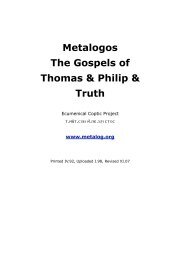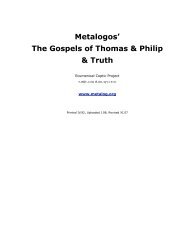Andrew Louth - Syriac Christian Church
Andrew Louth - Syriac Christian Church
Andrew Louth - Syriac Christian Church
You also want an ePaper? Increase the reach of your titles
YUMPU automatically turns print PDFs into web optimized ePapers that Google loves.
214 NOTES<br />
13 This is a good definition of what has been called the doctrine of<br />
enhypostasia, but I do not think that Maximus uses enhypostatos in this<br />
way. See Amb. 1, n. 5, above.<br />
14 Here, and elsewhere in this section, Maximus uses (or sometimes<br />
alludes to) the four adverbs used in the Chalcedonian Definition to<br />
express the integrity and genuine union of the two natures of Christ:<br />
without confusion, without change, without division, without separation<br />
(asynchytôs, atreptôs, adiairetôs, achôristôs).<br />
15 Denys the Areopagite, Divine Names, 8.5 (893A).<br />
16 Maximus is fond of this formulation of the relationship of the natures to<br />
the person of the Incarnate Word. Although the Council of Chalcedon<br />
said that Christ is recognized ‘in two natures’, the original version,<br />
followed by many Greek manuscripts, was ‘out of two natures’. Maximus<br />
combines them, and adds an assertion of direct identity. See Piret<br />
(1983), 203–39.<br />
17 Theotokos: literally, one who gave birth to God.<br />
18 ‘Intention’, here and later in the sentence, is gnômê, the intention, or<br />
inclination, that lies behind our voluntary acts.<br />
19 ‘Theandric’: an adjective, not invented by Denys, but popularized by his<br />
use of it in Ep.4, formed from the words for God (Theos) and [male] man<br />
(anêr, root: andr-) to characterize the person and indivisible activity of<br />
Jesus, God made man.<br />
20 The supporters of Severus of Antioch (‘Monophysites’) quoted the<br />
last few words of Denys’ Ep. 4 in support of their Christology at the<br />
council called by Justinian at Constantinople in 532. But they quoted it<br />
in the form ‘one theandric energy’, rather than ‘a certain new theandric<br />
energy’. It is this that Maximus is attacking here.<br />
21 The Greek is actually ‘goat-stag’: I have substituted our more familiar<br />
‘eagle-lion’, the griffin.<br />
22 The analogy of the iron in the fire for the union of the natures in the<br />
Incarnation is traditional in <strong>Christian</strong> theology: see, e.g., Origen, On<br />
First Principles II.6.6.<br />
23 Amb. 5 is the last of the later Ambigua, and this conclusion, addressed<br />
to Thomas, to whom the work is dedicated, and his other readers, is the<br />
conclusion of the whole work.<br />
24 Isa. 9:5 (LXX, according to the Alexandrine text, which is the one used<br />
in the Eastern <strong>Church</strong>).<br />
OPUSCULE 7<br />
1 On the question of whether the various pieces addressed to Marinus are<br />
addressed to the same person, see Sherwood (1952), 34.<br />
2 Possibly an allusion to the words said by the priest in the Byzantine<br />
liturgy as the warm water (the zeon) is added to the consecrated wine in<br />
the chalice before communion: see Brightman (1896), 394. This custom<br />
was probably introduced in the sixth century, and this may be the<br />
earliest evidence for it: see Wybrew (1989), 87–8.




